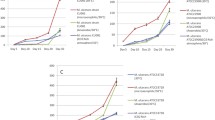Abstract
The purpose of this work was to evaluate the use of an alternative transport medium supplemented with a cyanobacterial extract (CE), free of animal derivatives, to preserve the viability of Helicobacter pylori strains during long-term transportation and allow its recovery from biopsy samples. The transport media evaluated were Mueller–Hinton broth 0.3% agar (MH) and 0.3% of CE (MH-CE). MH broth 5% fetal calf serum (FCS) was used as the reference medium (MH-FCS). Biopsy samples from 134 patients, H. pylori NCTC 11638 and six clinical isolates were studied. A higher recovery (p ≤ 0.001) at 4°C was obtained in MH-CE than in MH-FCS after 96 h of storage. Only MH-CE allowed recovery after 120 h. The H. pylori recovery at room temperature after 96 h was higher (p ≤ 0.005) in MH-CE than in MH-FCS. Similar survival rates were observed in biopsy samples conserved in MH-CE and MH-FCS at 4°C. The recovery after 48 h at room temperature in MH-CE was higher (p ≤ 0.05) than MH-FCS and was the only medium allowing recovery after 72 h. The MH-CE medium is a simple, inexpensive and animal derivatives-free transport medium that can be used to preserve H. pylori viability and its recovery from biopsy samples.



Similar content being viewed by others
References
Dunn BE, Cohen H, Blaser MJ (1997) Helicobacter pylori. Clin Microbiol Rev 10:720–741
Kusters JG, van Vliet AHM, Kuipers EJ (2006) Pathogenesis of Helicobacter pylori infection. Clin Microbiol Rev 19:449–490
Dierikx CM, Martodihardjo J, Kuipers EJ, Hensgens CMH, Kusters JG, Suzuki H, Groot N, van Vliet HM (2007) Serum- and animal tissue-free medium for transport and growth of Helicobacter pylori. FEMS Immunol Med Microbiol 50:239–243
Siu LK, Leung WK, Cheng AFB, Sung JY, Ling TKW, Ling JML, Ng EK, Lau JYW, Chung SC (1998) Evaluation of a selective transport medium for gastric biopsy specimens to be cultured for Helicobacter pylori. J Clin Microbiol 36:3048–3050
Heep M, Scheibl K, Degrell A, Lehn N (1999) Transport and storage of fresh and frozen gastric biopsy specimens for optimal recovery of Helicobacter pylori. J Clin Microbiol 37:3764–3766
Yuen B, Zbinden R, Fried M, Bauerfeind P, Bernardi M (2005) Cultural recovery and determination of antimicrobial susceptibility in Helicobacter pylori by using commercial transport and isolation media. Infection 33:77–81
Kusters JG, Gerrits MM, Van Strijp JA, Vandenbroucke-Grauls CM (1997) Coccoid forms of Helicobacter pylori are the morphologic manifestation of cell death. Infect Immun 65:3672–3679
Nilsson HO, Blom J, Abu-Al-Soud W, Ljungh AA, Andersen LP, Wadström T (2002) Effect of cold starvation, acid stress, and nutrients on metabolic activity of Helicobacter pylori. Appl Environ Microbiol 68:11–19
Vega AE, Cortiñas TI, Mattana CM, Silva HJ, Puig De Centorbi O (2003) Growth of Helicobacter pylori in medium supplemented with cyanobacterial extract. J Clin Microbiol 41:5384–5388
Silva PG, González DM, Aguilar EG, Silva HJ (1998) Nutritional evaluation of Cyanobacterium (Nostoc sp.) extract in Rhizobium cultures. World J Microbiol Biotechnol 14:223–228
Hammar M, Tyszkiewicz T, Wadström T, O’Toole PW (1992) Rapid detection of Helicobacter pylori in gastric biopsy material by polymerase chain reaction. J Clin Microbiol 30:54–58
Morton D, Bardhan KD (1995) Effect of transport medium and transportation time on culture of Helicobacter pylori from gastric biopsy specimens. J Clin Pathol 48:91–92
Boyanova L (2003) Influence of transport conditions and media on Helicobacter pylori isolation. J Med Microbiol 52:1129–1130
Xia HX, Keane CT, Chen J, Zhang J, Walsh EJ, Moran AP, Hua JS, Megraud F, O’Morain CA (1994) Transportation of Helicobacter pylori cultures by optimal systems. J Clin Microbiol 32:3075–3077
Acknowledgements
We thank Patricia Gomez and Ruben Majul for providing the gastric biopsy specimens. This work was supported by funds of C y T project 9303 from the Universidad Nacional de San Luis, San Luis, Argentina.
Author information
Authors and Affiliations
Corresponding author
Rights and permissions
About this article
Cite this article
Vega, A.E., Silva, H.J. & Cortiñas, T.I. Evaluation of a serum-free transport medium supplemented with cyanobacterial extract, for the optimal survival of Helicobacter pylori from biopsy samples and strains. Eur J Clin Microbiol Infect Dis 31, 135–139 (2012). https://doi.org/10.1007/s10096-011-1285-z
Received:
Accepted:
Published:
Issue Date:
DOI: https://doi.org/10.1007/s10096-011-1285-z



